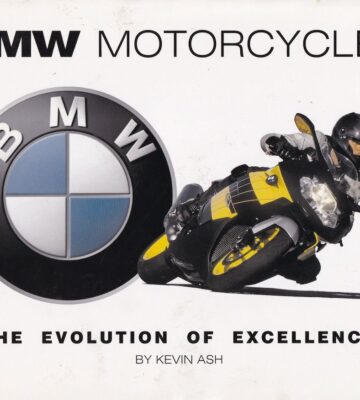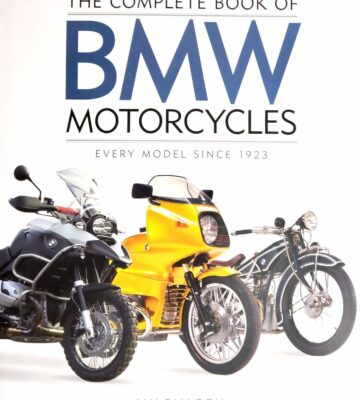As a relatively new recruit to the Order of the Roundel, I wanted to familiarize myself with BMW’s history and the evolution of its model lines. I’ve certainly followed coverage of the marque in the enthusiast press for decades and examined many offerings in person—in dealerships, at rider hangouts, and during several tours on borrowed boxers (GS, RT and ST) and a K-bike (pulling a trailer!). Yet it was clear to me I had plenty of catching up to do if was going to converse with other MOA members and not reveal an embarrassing level of ignorance. I needed a coherent narrative to pull everything together and give me perspective I couldn’t assemble from my piecemeal memories. After reading a list of book recommendations from Ron Davis, I got the two below. They both provided what I was looking for, albeit in different ways.
BMW Motorcycles: The evolution of excellence, by Kevin Ash
 This little 7”x9” hardback punches above its weight, as you might hope in light of its $29.95 price tag. Packed with large, mostly color photos and several drawings, it delivers visual entertainment no matter where you open its 174 glossy pages. Kevin Ash is a UK-based journalist whose bona fides include being the motorcycle correspondent for The Daily Telegraph, a weekly columnist for Motor Cycle News, and a contributor to Rider magazine here in the states, as well as having penned several other motorcycle books. His prose is clear enough, but a bit dry. Often it seems he’s listing facts as a skeleton onto which someone else might add flesh and blood later, and I felt a little shortchanged as I repeatedly found photo captions had simply been copied from nearby paragraphs. Nevertheless, the story is a good one, and he summarizes a great deal of historical information concisely, so readers won’t feel bogged down in detail. I was left wanting more detail about the bikes, especially technical aspects of older machines with which I was unfamiliar, but I contented myself with this as an introductory text, not something definitively comprehensive.
This little 7”x9” hardback punches above its weight, as you might hope in light of its $29.95 price tag. Packed with large, mostly color photos and several drawings, it delivers visual entertainment no matter where you open its 174 glossy pages. Kevin Ash is a UK-based journalist whose bona fides include being the motorcycle correspondent for The Daily Telegraph, a weekly columnist for Motor Cycle News, and a contributor to Rider magazine here in the states, as well as having penned several other motorcycle books. His prose is clear enough, but a bit dry. Often it seems he’s listing facts as a skeleton onto which someone else might add flesh and blood later, and I felt a little shortchanged as I repeatedly found photo captions had simply been copied from nearby paragraphs. Nevertheless, the story is a good one, and he summarizes a great deal of historical information concisely, so readers won’t feel bogged down in detail. I was left wanting more detail about the bikes, especially technical aspects of older machines with which I was unfamiliar, but I contented myself with this as an introductory text, not something definitively comprehensive.
The book is broken up into five eras, with the final one ending in 2006. There’s a tidy four-page timeline in the back laying out many of the events described, along with an interview of David Robb, head of BMW’s Motorcycle Design studio from 1993-2012. Considerable attention is paid to the company’s changing challenges and fortunes since 1917, including the obvious rise and fall of Germany in World War 2. BMW’s survival is explained as a natural result of its unwavering focus on innovative engineering, precision manufacturing, and superlative reliability—values carried over from its roots in aviation to its development of premium motorcycles. I found particularly interesting the paradox that BMW seems to have just as often set mainstream trends as it has eschewed them. It has been a balancing act, maintaining the traditionalists’ loyalty as they protested the new ideas responsible for drawing more buyers into the fold—and keeping the brand financially viable while so many others died off.
Toward the end of the book, Ash covers BMW’s accelerating expansion into numerous non-touring market categories and the proliferation of models in a cursory fashion, in contrast to his more granular presentation of the evolution of early bike types. Again, I wanted additional detail, but since I already knew a lot more about the BMWs of the last few decades, I didn’t need it. Overall, I’d say this is a pretty good place to start if it’s breadth you’re after. The other volume here will hold more appeal if you also want depth.
The complete book of BMW motorcycles: Every model since 1923, by Ian Falloon
 You probably wouldn’t sit down and read the dictionary or a set of encyclopedias from start to finish. Such volumes are meant to serve as references for specific inquiries, vast resources to be consulted over time as needed. This 312-page hardback tome could be treated similarly, or flipped through randomly as a 10”x12” coffee table adornment; it certainly contains a treasure trove of historical and technical details, along with many hundreds of photos, illustrations, and charts depicting virtually every motorcycle built by BMW over the last century. (I say “virtually” because its publication in 2020 precluded coverage of the very latest models, although the R18 concept bike makes an appearance.) Yet this work can also be read as a narrative, especially regarding the marque’s early history. While chapters are segmented by numerous bold headings that allow quick locating of particular data, and there are lots of stand-alone sidebars, the text is more than just a recitation of facts. It reads like a well-done seminar wherein a wealth of information is delivered in highly palatable prose—not quite the continuous storyline of a documentary, but rather a collection of cleanly written vignettes in chronological order. At $55, it offers much more than twice the value of the Ash book.
You probably wouldn’t sit down and read the dictionary or a set of encyclopedias from start to finish. Such volumes are meant to serve as references for specific inquiries, vast resources to be consulted over time as needed. This 312-page hardback tome could be treated similarly, or flipped through randomly as a 10”x12” coffee table adornment; it certainly contains a treasure trove of historical and technical details, along with many hundreds of photos, illustrations, and charts depicting virtually every motorcycle built by BMW over the last century. (I say “virtually” because its publication in 2020 precluded coverage of the very latest models, although the R18 concept bike makes an appearance.) Yet this work can also be read as a narrative, especially regarding the marque’s early history. While chapters are segmented by numerous bold headings that allow quick locating of particular data, and there are lots of stand-alone sidebars, the text is more than just a recitation of facts. It reads like a well-done seminar wherein a wealth of information is delivered in highly palatable prose—not quite the continuous storyline of a documentary, but rather a collection of cleanly written vignettes in chronological order. At $55, it offers much more than twice the value of the Ash book.
To be clear, the technical detail for each bike is nowhere near the depth of, say, a Kevin Cameron new-model exposition. Readers must possess some knowledge of terms (e.g., side-valve engine, variable valve-timing) and go elsewhere for involved explanations of how the noted systems function. Charts contain many basic facts, however, and allow easy identification or comparison of such details as engine nomenclature, displacement, bore & stroke, compression ratio, horsepower, transmission, dry weight, and frame, brake and suspension type—even the quantity produced by the factory, and the range of engine and frame serial numbers.
Ian Falloon is a New Zealander with a slew of motorcycle books to his credit, mostly devoted to Italian machinery, but with significant attention to BMW over the decades of his journalism. He has written for many enthusiast magazines in the US and Australia, including Classic Bike, Cycle World, and Motorcyclist. Of particular interest to MOA members, he has done deep-dive technical books on air-cooled boxers (The BMW Boxer Twins 1970-1996 Bible, and Original Air-Cooled Boxer Twins, 1950-1996) and one focused tightly on the iconic R 90 S. Another book, The BMW Story, appears (based on what I could find online) to have considerable overlap with the work reviewed here, albeit in a smaller, briefer format—but at nearly the same price.
While Falloon’s writing is more engaging than Ash’s, it isn’t quite as prone to lauding BMW’s devotion to high quality. After reading both, Falloon’s comes off as the more even-handed, whereas Ash’s leans slightly in the direction of infomercial. If you’re going to buy only one, get Falloon’s. If you buy both, read Ash’s first; it’s a nice primer for Falloon’s, but it’d be a let-down afterward.


